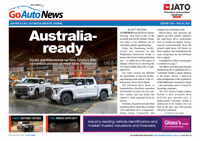Make / Model Search
News - General News - TechnologyUS switches on to reversing camerasWinging it: Concept cars such as Volkswagen’s hyper-miling XL1 have used cameras in place of drag-inducing wing mirrors. Reversing cameras to become law in US as car-makers seek to replace wing mirrors1 Apr 2014 By BARRY PARK REVERSING cameras will become compulsory on all new cars sold in the US from mid-2018 as the government moves to minimise the number of people killed or injured in “backover” mishaps. But the move has also prompted an alliance of car-makers to petition the government to allow them to swap out wing mirrors for slimline cameras, playing on the idea that the US is slowly opening up to new in-car technology. The National Highway and Transport Safety Administration announced overnight that all passenger cars and light trucks – and even some buses – would soon need to fit the technology in an effort to “significantly reduce the risk of fatalities and serious injuries”. Interestingly, the US Government agency illustrated its story with an image of the Ford Territory’s reversing camera fitted to the locally made SUV as part of a major facelift introduced to the range in 2009. "Safety is our highest priority, and we are committed to protecting the most vulnerable victims of backover accidents – our children and seniors," US transportation secretary Anthony Foxx said. "As a father, I can only imagine how heart wrenching these types of accidents can be for families, but we hope that today's rule will serve as a significant step toward reducing these tragic accidents." The move in the US follows similar calls to mandate the technology in Australia, particularly for larger SUV-style vehicles where rearward visibility is often an issue. The latest death to occur in Australia was a three-year-old toddler who was run over in the driveway of her Sunshine West home in February. Last year, the Department of Infrastructure and Regional Development commissioned the Monash University Accident Research Centre to prepare a scoping study on reversing cameras. “The purpose of the scoping study was to establish what data is available around the world in relation to reversing cameras, and to examine whether the effectiveness of such technologies can be measured from the available data,” a spokesperson for the department told GoAuto. “The department will publish the scoping study shortly and a further (second-stage) research project will be undertaken on the effectiveness of reversing cameras.” The spokesperson said the results of the second-stage study would be sent to the UN World Forum for Harmonization of Vehicle Regulations, which tries to set global standards for car-makers to follow. “The United States will be one of Australia’s partners in the second-stage research project and developments in the US will be considered closely,” the spokesperson said. While reversing cameras are still mainly confined to higher-end variants on low-cost cars, even prestige brands are yet to roll out the technology across their showrooms. That will all change next week with the launch of the facelifted Lexus CT200h, which is the last vehicle in the showroom from the luxury arm of Japanese car-maker Toyota to add reversing cameras across the range. "Lexus' commitment to visibility and relating to safety is well documented, with Lexus IS, GS, RX and LX taking five-star ratings in NRMA reversing visibility studies," Lexus Australia chief executive Sean Hanley said. "Realising the potential visibility shortcomings of larger vehicles, Lexus was the first Australian marque to offer reversing cameras as standard on an SUV, with its RX 330 in 2003. "Additionally, Lexus is continually developing and offering new exterior vision technologies including the front, rear, left and right view cameras fitted as standard on LX 570, as well as the availability of wide-view side cameras on RX," he said. Bosch Australia developed a system using reversing sensors that can sense if a child or other object is behind the vehicle and automatically apply the brakes without the need for a reversing camera. Meanwhile, the US-based Auto Alliance has taken the NHTSA’s approval of reversing cameras as a sign that the government may also be ready to allow car-makers to replace wing mirrors with cameras – a step up in technology that many concept cars now feature and designers such as Jaguar’s Ian Callum have long called for. “Today, the alliance is petitioning NHTSA to allow automakers to use cameras as an option to the conventional side-view and rearview mirrors,” the group, which represents car-makers including BMW, Chrysler, Porsche and Volkswagen, said in a statement issued after the NHTSA’s announcement. “Today’s mirrors provide a robust and simple means to view the surrounding areas of a vehicle. “Cameras will open opportunities for additional design flexibility and innovation. This idea has been in development since the 1990s, when the US Department of Energy partnered with automakers to produce an energy-efficient concept car with cameras instead of side-view mirrors,” it said. In other technology developments, Japanese automotive electronics specialist Denso says it has developed in-car cameras that are smart enough to recognise if a pedestrian is looking at a smartphone instead of the road, and react accordingly. The camera uses image-processing technology to predict what a pedestrian is doing, and can even determine height and even the speed and direction the pedestrian is walking in. A car can use this data to predict if the distracted pedestrian is likely to stray in its path, and automatically apply the brakes. Denso’s computer graphics-based technology was demonstrated at the GPU Technology Conference in California last week.  Read more |
Click to shareGeneral News articlesResearch General News Motor industry news |












Facebook Twitter Instagram